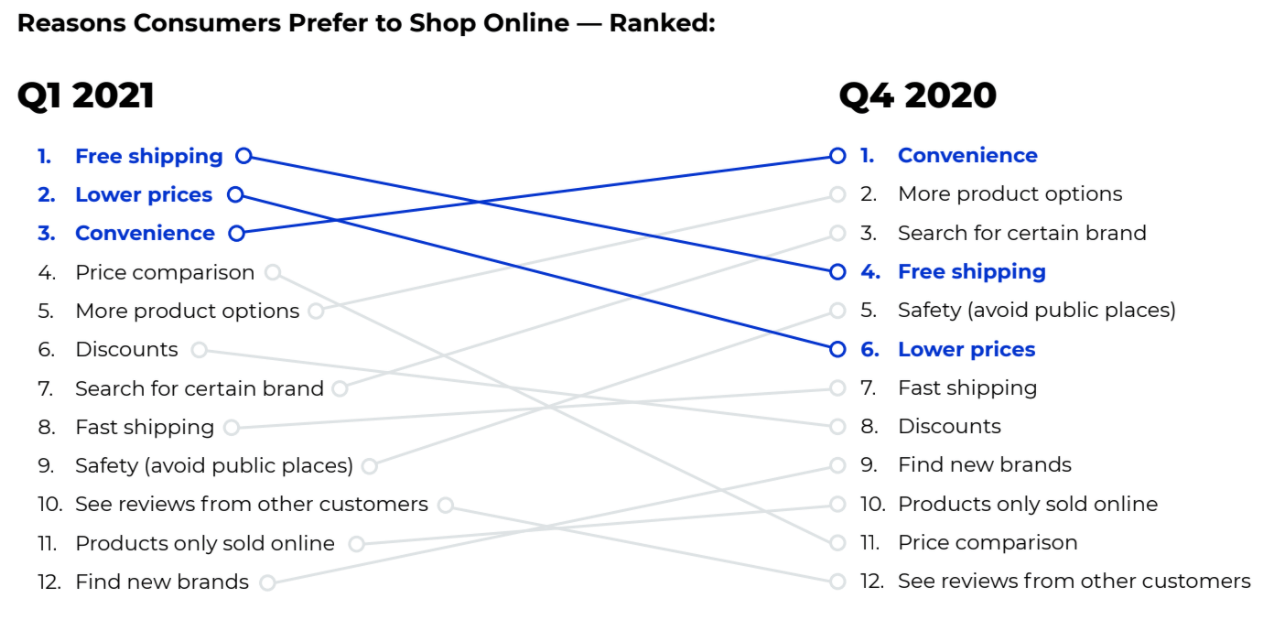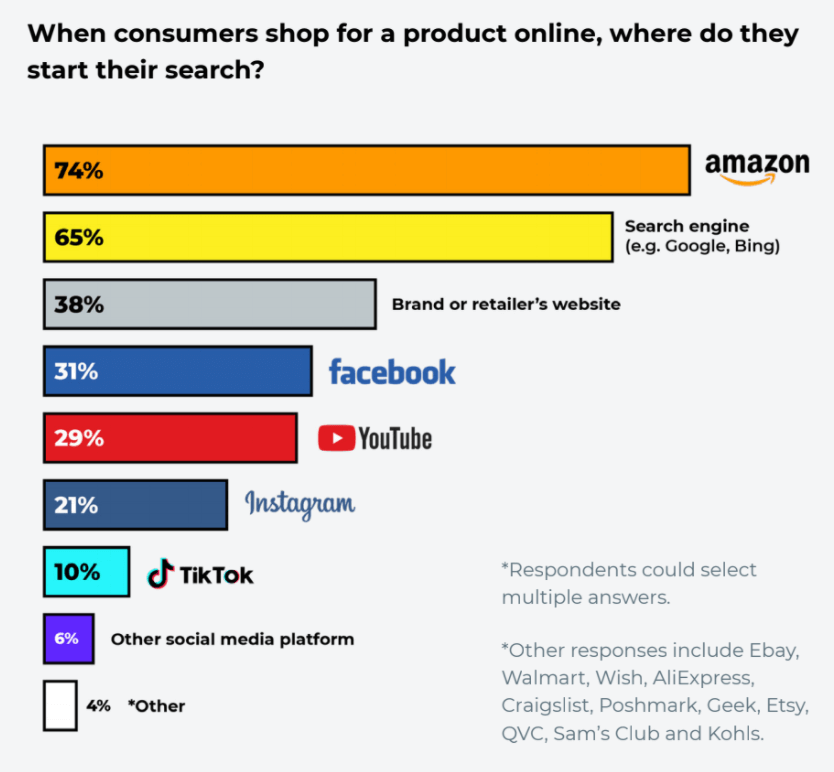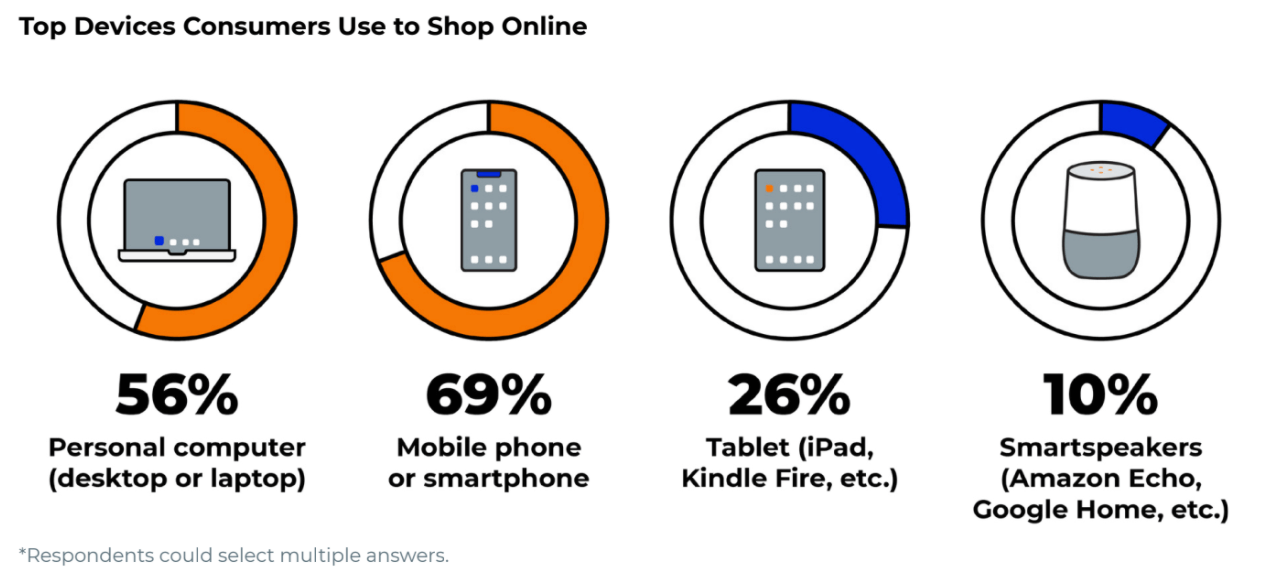The past year has seen a rapid uptake of existing digital shopping solutions in lieu of in-person shopping, including new social and mobile commerce trends. For ecommerce business owners trying to keep up with the shifting retail status quo, this can feel like a double-edged sword.
On the one hand, tech-forward shopping methods add value for customers, as the digital shopping experience can be personalized, interactive, and budget-friendly. On the other, retailers now have more channels, advertising methods, and payment options to keep up with.
Consumers are favoring tech-forward shopping methods
Businesses’ quick shifts to digital channels in 2020 let U.S. consumers maintain access to the products and services they needed, despite store closures and social distancing measures. In 2021, U.S. shoppers increasingly rely on the internet to buy everything from beauty products to clothing to toys.
The digital trend holds even for products and services for which an in-person component has historically been necessary. Consider grocery shopping, which throughout the COVID-19 pandemic has remained the top category for which consumers prefer shopping in-store. In 2021, 48% of consumers are buying groceries online, with 26% opting for curbside pickup. Other examples lie in the wellness and entertainment industries:
- 38% of Americans have attended telemedicine appointments
- 30% have participated in virtual workouts
- 29% are seeking online entertainment through virtual concerts and museum tours
Virtual shopping also offers strategies to save money, and tech-savvy consumers are getting on board in response to pandemic-related financial strain. Shopping online makes it easier to research products, hunt for deals, and compare prices across different retailers — including those that offer flexible payment options or accept cryptocurrency.
| Money-saving methods in 2021 | U.S. consumers participating |
| Look for ways to save money when shopping (e.g., coupons, promotions, deals) | 75% |
| Typically research products before buying | 69% |
| Typically spend time planning or making lists in preparing for shopping trips | 69% |
| Look for the product with the lowest price | 68% |
| Prefer shopping from retailers that offer flexible or other payment options | 51% |
| Often use deal-finding browser extensions or plug-ins | 45% |
Online shopping streamlines the purchasing process, adding both ease and value as shoppers look to stay within their budgets. Of the many reasons to shop online, consumers rank lower prices and convenience at the very top.

Social commerce trends
One of the most remarkable trends to emerge during 2020 is consumers’ use of social media channels to search for and purchase products.

Over half (54%) of consumers say they’ve bought something they first learned about on social media, and just under a third head for Facebook or Youtube when starting a product search.
Social media channels influencing consumer purchases
| Channel | U.S. consumers who shop |
| 46% | |
| YouTube | 37% |
| 29% | |
| 16% | |
| Tik Tok | 16% |
| Snapchat | 14% |
Mobile commerce trends
The hardware available to consumers to shop online is broadening, too, with a trend toward mobile and hands-free purchasing. More consumers shop on smartphones than personal computers these days, and 10% even buy products from their smartspeakers.

Five ways retailers can adapt to social and mobile commerce trends
All signs point to the likelihood that the shift to digital shopping will outlast the COVID-19 pandemic. In fact, three in four Americans believe the majority of consumer shopping will happen online in the future, and nearly half say they’d be fine with never shopping in a physical store again.
Retailers should adjust their business strategies accordingly, starting by embracing consumers’ enthusiasm for digital content.
1. Hone your social media strategy
If you’re not already using Instagram, Youtube, Facebook, or TikTok to promote your brand, it’s time to start.
Expanding your marketing efforts to social media will help you capture the search traffic noted above — and can make your brand resonate with a digital audience in ways that product listings just can’t. You’ll have more opportunities to create customer interactions, source feedback, and inspire user-generated content (UGC) through engaging your followers (and their extended networks).
As we’ve mentioned in previous articles, it’s important to leverage social media to craft a brand identity that’s authentic, relevant, and expressive, rather than using it to aggressively market your products. Focus on creating content that other users will want to share, be it niche-specific memes, helpful videos, or snippets of stellar product reviews. If your post goes viral, your brand or product could be seen by millions of users — and receive a hefty boost in sales to boot.
2. Advertise with video content
A corollary to marketing your brand on social media is creating video content. Thanks to the popularity of casual, short-form videos on Instagram and TikTok, this is easier than it sounds. You can shoot 30-60-second-long (or shorter) videos of your product in action, put your own spin on a viral video trend, or answer frequently-asked questions about your product, all from a smartphone.
Videos also count toward non-social media advertising. For instance, Sponsored Brands Video Ads are a great way to catch shoppers’ attention as they scroll through Amazon search results pages. Keep in mind that Amazon’s video ads should be high-quality — if you’re not a skilled videographer, you may want to hire a professional to make sure your videos satisfy Amazon’s quality guidelines.
3. Offer discounts, deals, and flexible payment options
In 2021, consumers’ financial worries are serious — as is their commitment to finding deals when shopping online. Shoppers value their ability to easily compare prices, research products, and use deal-sniffing software like Honey and Pricescout.
When two-thirds of your audience is looking for products with the lowest price, running promotions or offering coupons once in a while isn’t a bad idea. One way to do this on Amazon is by creating virtual bundles, combining complementary items in your product line for a discounted price.
Retailers could also consider providing buy-now-pay-later options like Klarna and Afterpay.
4. Ensure free shipping
Access to free shipping is the number-one reason consumers shop online, and can spell the difference between a purchase from your online storefront versus from a brick-and-mortar retailer nearby. Free shipping can also prompt customers to buy more items at a time, saving retailers some fulfillment cost.
5. Boost your online review count
Product reviews exert a strong sway on conversions. 71% of consumers say they’re influenced by products with the best ratings and reviews, and nearly as many (68%) say the same about reviews that feature photos or videos.
Getting customer feedback is tough, but we’ve developed some strategies over the years to help that review count climb.
We recommend implementing as many of these strategies as possible as consumers continue to adopt more tech-forward ways of shopping. Online shopping isn’t going anywhere, and the better equipped you are to meet your customers’ evolving expectations, the more you stand to grow your brand.

 No Comments
No Comments